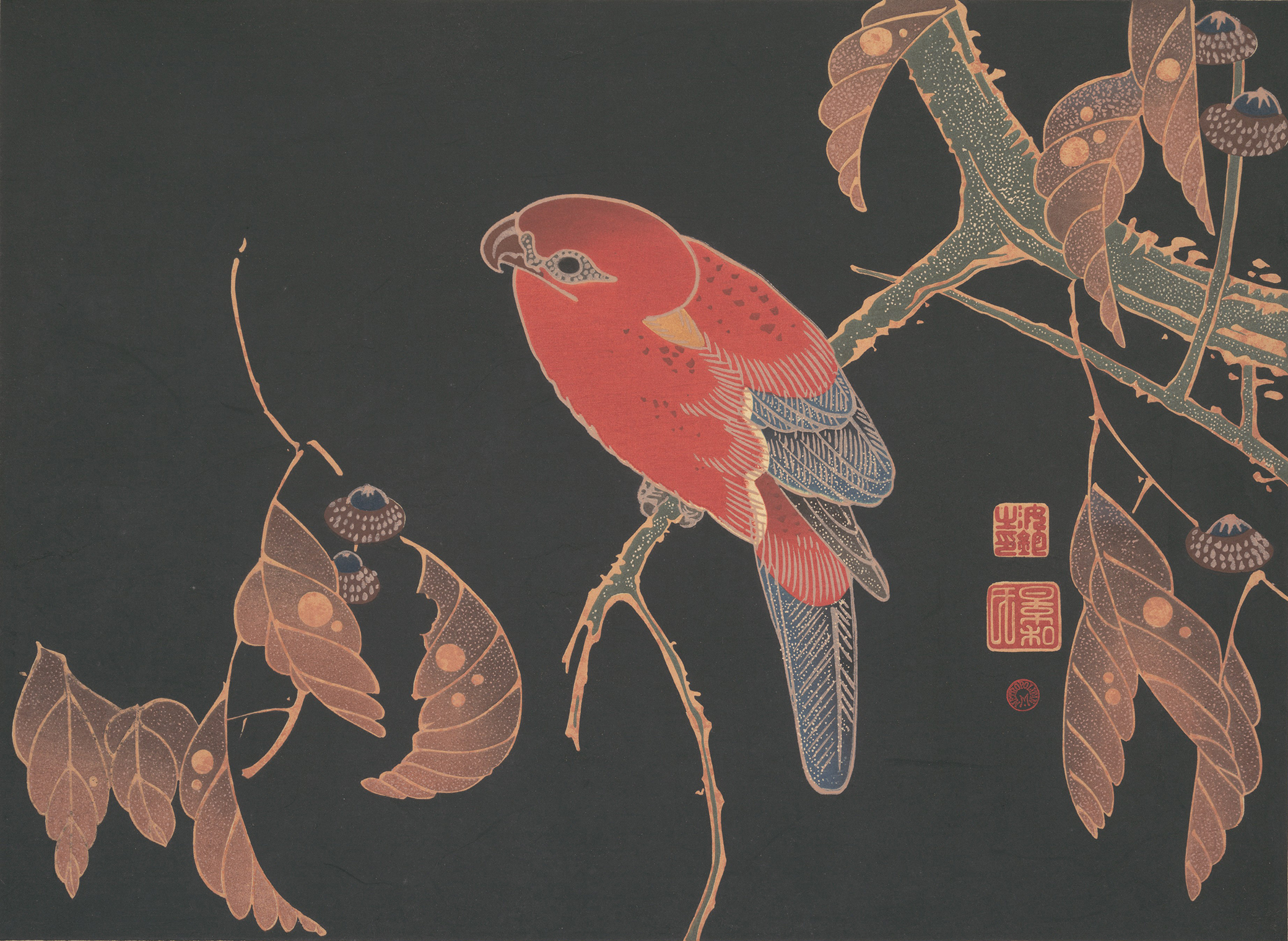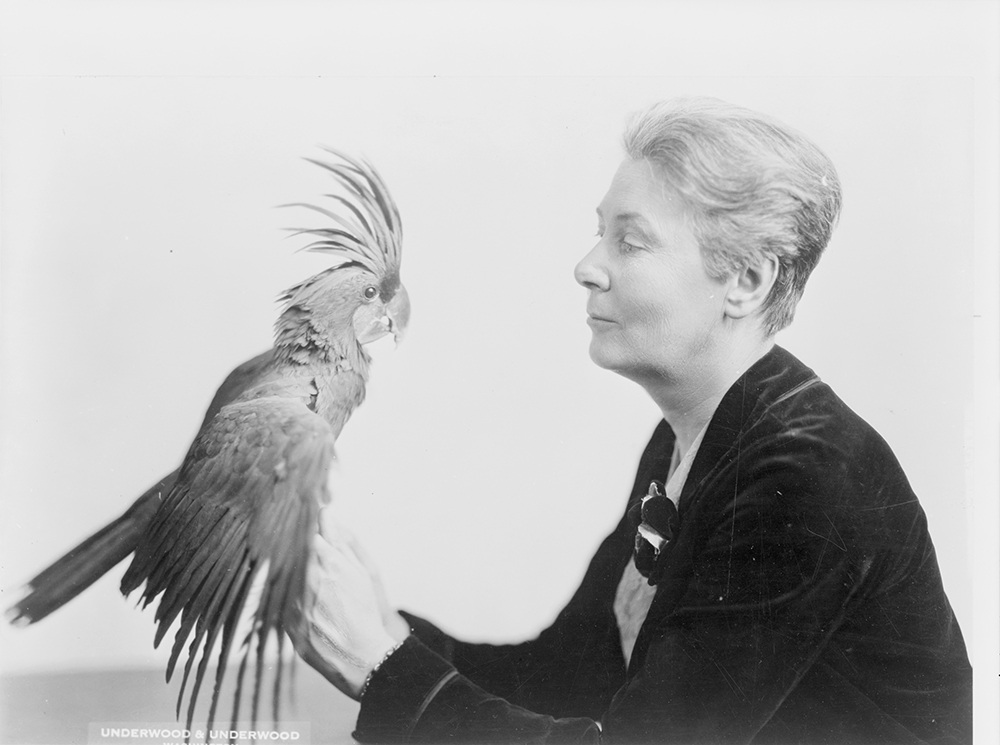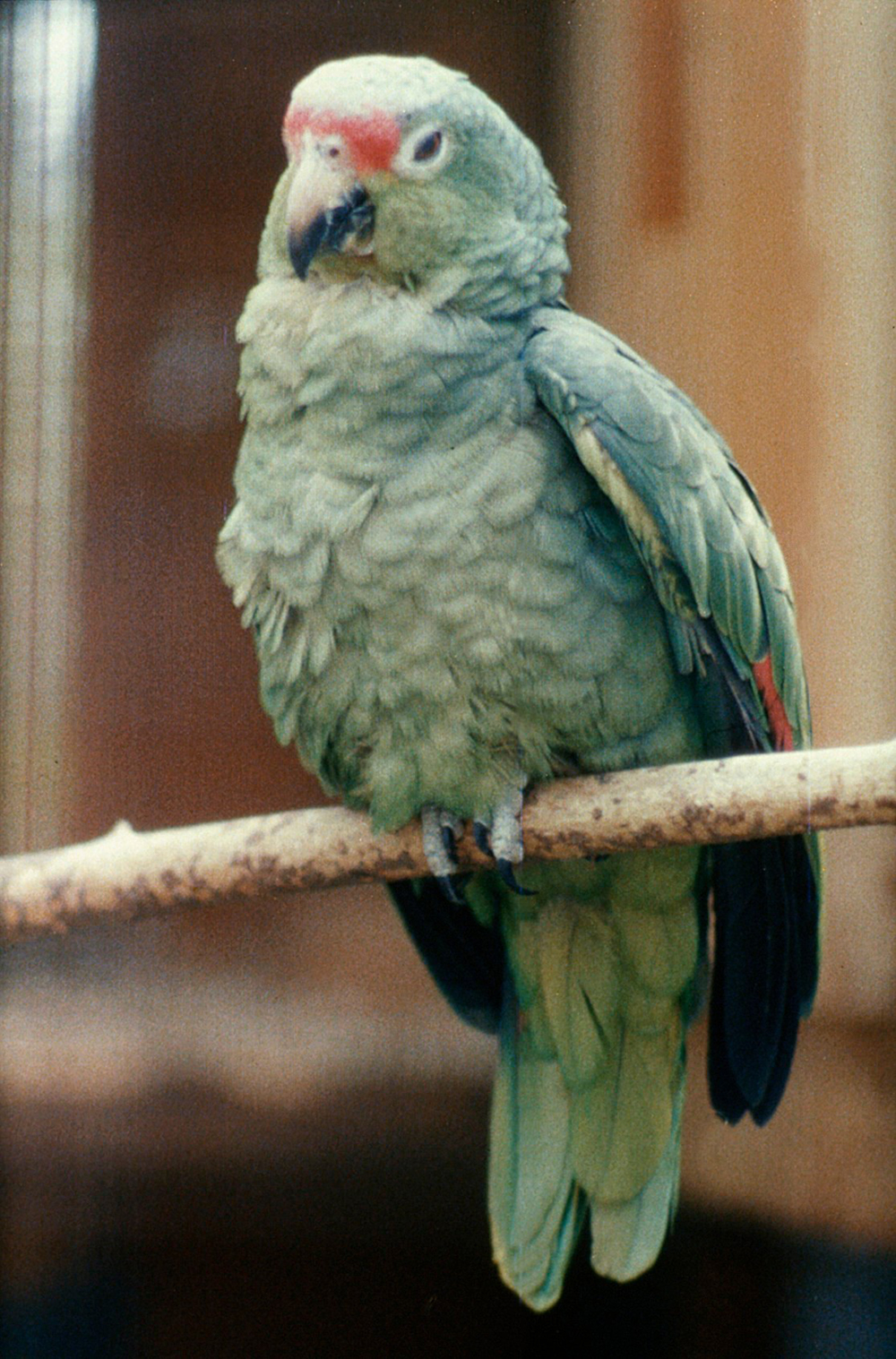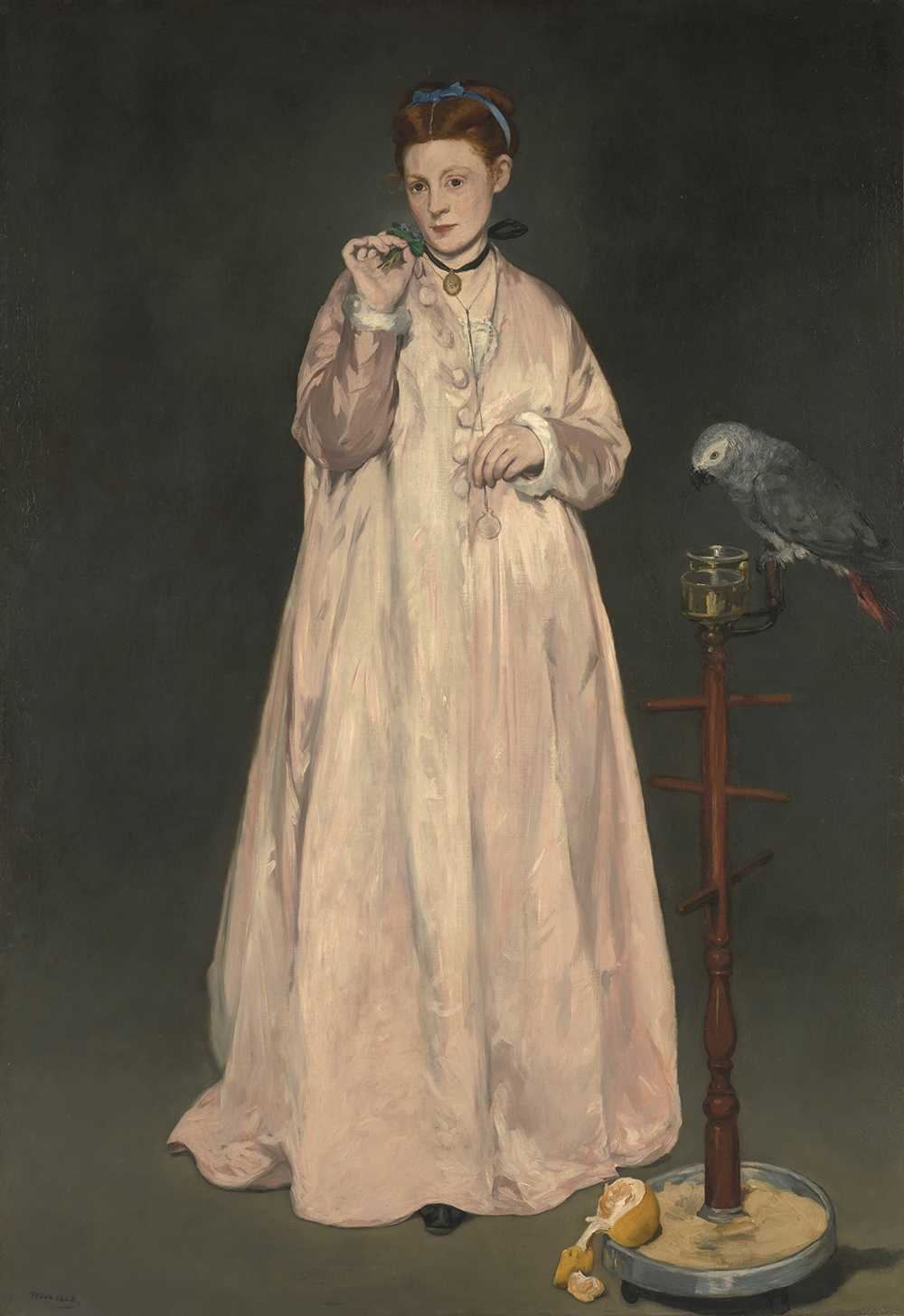
Red Parrot on the Branch of a Tree, by Itō Jakuchū, c. 1900. The Metropolitan Museum of Art, Rogers Fund, 1925.
On January 6, 1930, Dr. Willis P. Martin paid an urgent house call on a family in Annapolis, Maryland. Lillian, her daughter Edith, and Edith’s husband Lee Kalmey, the owner of a local auto repair shop, had begun to feel feverish shortly after Christmas, and all three were now deathly ill. At first, they attributed their symptoms to influenza and the depressive effects of the recent stock market crash, which had hit Kalmey’s business as hard as any, but in the first week of the new year their condition had taken a decided turn for the worse. To the chills and generalized aches and pains typical of influenza was now added an irritable dry cough, accompanied by constipation and exhaustion that alternated with headaches and insomnia. For large parts of the day, Lillian, Edith, and Lee lay somnolent as logs, the silence broken only by their intermittent mutterings. By contrast, when awake they would be restless and prone to fits of violent excitement. The most worrying symptom of all, however, was the rattling sound coming from deep within their lungs.
Dr. Martin suspected pneumonia, possibly mixed with typhoid fever. However, Lillian’s husband, who had eaten the same meals as the rest of the family, was perfectly well, which tended to rule out a food-borne illness. The only other member of the household who had been sick was a parrot that Lillian’s husband had purchased from a pet store in Baltimore and which Edith and Lee had kept at their home in the run-up to the Yuletide festivities so as to present the bird to Lillian as a surprise on Christmas Day. Unfortunately, by Christmas Eve the parrot’s plumage had grown ruffled and dirty and the creature was showing signs of listlessness. Come Christmas Day the parrot was dead.
Dr. Martin was baffled by the family’s symptoms and shared his bewilderment with his wife. At first, Mrs. Martin was similarly puzzled. Then Dr. Martin mentioned the dead parrot. It might be a coincidence, she said, but the previous Sunday she had been reading about an outbreak of “parrot fever” in a theatrical troupe in Buenos Aires. According to the newspaper report, the disease was being blamed for the death of two members of the company, who, in common with other members of the cast, had been required to interact with a live parrot on stage. That bird was now dead and pet owners throughout Argentina were being warned to report sickly psittacines—birds in the parrot family—to the authorities.

It sounded unlikely, ridiculous even, but Martin was not the type to take a chance. Instead, he sent a telegram to the Public Health Service in Washington, DC:
request information regarding diagnosis parrot fever…what information available regarding prevention spread of parrot fever…can you place supply parrot fever serum our disposal immediately. wire reply.
Martin was not the only doctor puzzled by the sudden appearance of mysterious pneumonias accompanied by typhoid-like symptoms in the United States that winter. By now similar telegrams were arriving at the PHS from Baltimore and New York, and health officials in Ohio and California were fielding similar requests for information. Like Martin’s telegram, these communications ended up on the desk of Surgeon General Hugh S. Cumming, who passed them on to his subordinate, Dr. George W. McCoy, the director of PHS’ Hygienic Laboratory. A veteran of the bubonic plague investigations in San Francisco, McCoy was renowned for discovering tularemia, dubbed the “first American disease” because the bacterium was first identified in McCoy’s lab in California, and was then the most celebrated bacteriologist in America.1 If anyone could solve the outbreak, Cumming figured, it was McCoy. But when McCoy read Martin’s telegram he could not help smiling. Parrot fever? It sounded like the sort of diagnosis you might encounter in the medical columns of the yellow press or a joke in the funny pages. Certainly, McCoy had never heard of parrot fever. But then McCoy was a busy man—America was in the grip of an influenza epidemic, a recrudescence, it was feared, of the Spanish flu, and he and his deputy, Charlie Armstrong, were working day and night on a serum for postvaccinal encephalitis, a “sleeping sickness” that affected some individuals who’d received the smallpox vaccine. Nevertheless, McCoy thought it best to check with his colleague.
“Armstrong, what do you know about parrot fever,” McCoy demanded.
“What do I know about it? I don’t know a thing about it,” Armstrong admitted.
Within days, however, McCoy and Armstrong would come to rue their ignorance as one by one laboratory workers tasked with investigating whether parrots were implicated in the outbreaks seen in Annapolis and elsewhere, fell ill. Indeed, by February Armstrong and several other personnel at the “Hygienic,” as the ramshackle red-brick laboratory overlooking the Potomac was known, had been removed to the nearby U.S. Naval Hospital. By the time the outbreak concluded in March, Armstrong’s longtime assistant, Henry “Shorty” Anderson, was dead. In the end, it fell to McCoy to conduct the critical passage experiments on parrots in the basement of the Hygienic in an attempt to isolate the “virus” of psittacosis and develop a serum. But the tests were inconclusive and in the end McCoy had been forced to chloroform the birds and fumigate the Hygienic from top to bottom to prevent the putative virus from escaping the building. As the science writer Paul de Kruif put it in his book Men Against Death, McCoy “never smiled nor even muttered” as he performed this grim task, “but just killed and killed and at the end of it swashed out every last cage with creosol, and gave all the dead bodies of those assorted unhappy experimental creatures a decent and thorough burning in the laboratory incinerator.”
Today few people recall the hysteria surrounding the great parrot fever pandemic of 1929–1930, but in an era when parrots were all the rage and itinerant peddlers went door-to-door with “lovebirds” for widows and bored housewives, the idea that one’s pet parrot or parakeet might be harboring a deadly pathogen from the Amazon was the stuff of domestic nightmares and a story few newspaper editors could resist. Indeed, were it not for the yellow press, and the Hearst newspaper group in particular, it is unlikely that the connection between parrots and psittacosis would have come to light so fast, or that the PHS would have reacted so quickly. The story about the Argentine theatrical troupe had appeared in the January 5 edition of the American Weekly, a lavish supplement distributed with the Sunday editions of the New York American and other papers in the Hearst group, under the headline “Killed by a Pet Parrot.” Mrs. Martin probably read the story in the Baltimore American sandwiched between an article about a tony twice-divorced couple and the “astonishing confessions” of a slave trader. Morrill Goddard, the editor of the American Weekly, had spotted the tale about the troupe in an obscure Argentine scientific journal the previous November and had wired the paper’s Buenos Aires correspondent, asking for further details. The correspondent found the theater where the troupe had been performing shuttered, but managed to trace the surviving cast members. The most prominent victim had been Carmen Mas, the show’s star and a well-known Argentinian comedian. Her leading man, Florencia Paravincini, had also been felled by the disease, but, according to the Hearst correspondent, after “seventeen days of agony” had recovered. Nevertheless the “bacillus passed from the parrot” had exacted a considerable toll. Prior to the attack Paravincini had been a “big, heavyset man with hair as black as leather.” Now, he weighed less than one hundred pounds and his hair was “as white as snow.” It was a doctor at the hospital who had put two and two together. After speaking to the company’s prop man, he learned that the actors had been required to pet the parrot on stage and that said bird had since died. As a result, an alert was issued by the Asistencia Publica, the Argentine National Health Board, and soon reports of similar outbreaks connected to sickly parrots but wrongly diagnosed as typhoid or influenza were coming to light. In Cordoba, fifty cases were traced to a parrot dealer who had set up shop in a local boarding house. His birds were promptly slaughtered but too late to prevent the distribution of other suspect psittacines. According to the correspondent, the outbreaks in Argentina were entirely avoidable and would not have occurred had dealers observed some simple precautions familiar to indigenous forest peoples accustomed to living alongside wild birds in their natural habitat.
In semitropical parts of Argentina where the parrots are caught, the parrot disease is well known among the natives, who never have the creatures for pets, and keep away from them unless they make a business of catching and shipping them to the cities. The professional parrot catcher takes care not to get hold of a sick bird. If by mistake he does catch a “quiet one” he knows it is deadly and lets it go as well as any healthy captives with which it may have come in contact.

The outbreak in Cordoba was subsequently traced to a consignment of five thousand parrots imported from Brazil that had been kept in unsanitary conditions in overcrowded crates. By the time Goddard came to learn of the outbreaks, the connection between psittacosis and Brazilian parrots was well known in Argentina and the authorities had outlawed the trade. However, passengers on cruise ships calling at Buenos Aires were largely ignorant of the ban, creating an opening for unscrupulous dealers to offload their sickly birds on unsuspecting tourists. It was this practice that most likely led to the introduction of psittacosis to the United States.
As the term pandemic implies, the United States was not the only country affected. In the summer of 1929, four cases of suspected psittacosis were reported in Birmingham, England, and by March of the following year one hundred cases had been recorded across England and Wales. One notable early victim was a ship’s carpenter who had purchased two parrots in Buenos Aires, only to see them perish on the voyage to London (when he presented at the London Hospital in December 1929, the carpenter’s symptoms were mistaken for typhoid, just as with the Kalmeys in Annapolis). Although most cases seemed to involve sustained exposure to live birds, British researchers observed that this was not always the case, one example being a man who had merely stopped for a beer in a public house in which a sick parrot had been present. By January 1930, similar outbreaks were also being reported in Germany, Italy, Switzerland, France, Denmark, Algeria, Holland, and Egypt. There were even reports of an outbreak in Honolulu.
During the first week of illness, most patients appeared comparatively well in spite of running high temperatures. After five or six days, however, headache, insomnia, and an irritable cough would set in, and they would complain of profound exhaustion, their symptoms often being accompanied by lung consolidation. Soon after, many patients slipped into delirium and became semicomatose. This was the critical period, with death often following soon after. However, in other cases, just as it looked as if the illness was about to take a fatal turn, the patient’s temperature would fall and his condition would suddenly improve. Full recovery might take a further week or two, and sometimes as long as eight. During this protracted convalescence period, physicians had to constantly monitor their patients’ temperatures, as relapses were frequent.
It was not until much later, of course, that doctors would become familiar with the typical course of the illness and recognize it as psittacosis. Instead, it was the story in the American Weekly and Dr. Martin’s telegram that appears to have alerted Cumming to the outbreak and prompted him to put McCoy and Armstrong onto the case. By then, psittacosis was widely seeded in cities on the eastern seaboard of the United States and had already been communicated via dealers to other caged birds popular with American consumers, such as shell parakeets (Australian budgerigars). The result was that as parrot fever spread from Annapolis, to Baltimore, New York, and Los Angeles, the outbreak became a headline writer’s dream. “Parrot Fever Hits Trio at Annapolis,” declared the Washington Post on its front page on January 8, 1930. “Parrot Disease Fatal to Seven,” reported the Los Angeles Times three days later. “Women’s Case Brings Parrot Victims to 19,” announced the Baltimore Sun on January 16.

For widows and bored housewives, caged birds were the FM radios of their day. The chirping of canaries provided a soothing background music, punctuating the drudgery of household tasks, and, in the case of parakeets—parrots’ smaller, sprightlier cousin—their facility for words and humorous phrases provided a facsimile of human conversation. Estimating that New York City alone was home to some thirty thousand parrots, National Geographic dubbed Amazons and African grays “the ballyhoo barkers of birdom, noisy clever, sideshow performers of the tropical forest rainforest.” Their pint-sized cousin, the lovebird (genus Agapornis), had a reputation for similarly buffoonish behavior, and with their talent for hanging upside down or dancing on their owners’ shoulders were a source of endless amusement for children and an entertainment for houseguests. Little wonder then that in 1929 nearly fifty thousand parrots, parakeets, and lovebirds, and some five hundred thousand canaries were imported to the United States. These birds arrived not only from Brazil and Argentina but from Colombia, Cuba, Trinidad, Salvador, Mexico, and Japan. The majority entered the United States via New York, the center of the East Coast bird trade. However, in the case of Australian budgerigars, the main ports of entry were San Francisco and Los Angeles. Indeed, following the Wall Street crash in 1929, a huge bird breeding industry had grown up in Southern California, with hundreds of independent breeders raising lovebirds in their backyards to supplement their incomes. To the naked eye these birds appeared perfectly healthy. However, when they were packed into crowded aviaries or containers and shipped across state lines, many began to shed the virus and transmit the infection. It would prove an invisible and combustible combination.
1 McCoy first isolated the bacterium of tularemia in 1911 while examining squirrels for plague lesions in Tulare County, California. Transmitted by ticks, mites, and lice, tularemia is endemic to every state in the U.S., the principal reservoirs being wild rabbits and deer. In humans, the tick or deer fly bites can result in ulceration and swelling of the lymph glands; hence its confusion with plague.↩
Excerpt from The Pandemic Century: One Hundred Years of Panic, Hysteria, and Hubris by Mark Honigsbaum. Copyright © 2019 by Mark Honigsbaum. Reprinted with permission of W.W. Norton & Company, Inc. All rights reserved.
